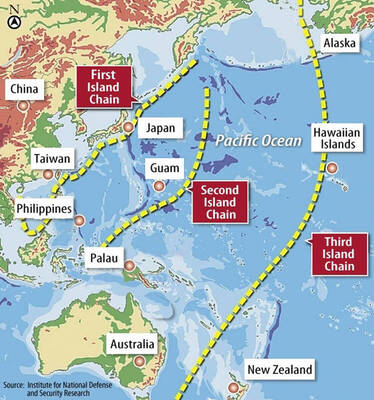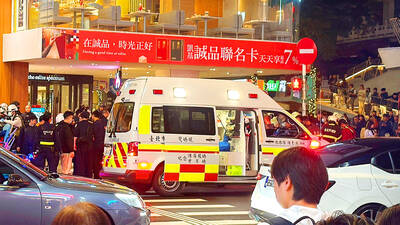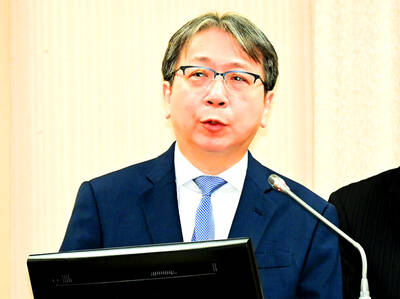A National Security Bureau official told the Liberty Times, the Taipei Times' sister newspaper, that China is about to deploy land-attack cruise missiles (LACMs) within striking distance of Taiwan on a large scale beginning later this year in an effort to bypass Taiwan's current missile defense capabilities.
"The US Department of Defense will underscore China's deployment of cruise missiles against Taiwan in its annual report on China's military power, which is expected to be released in May," he was quoted by the paper yesterday as saying.
The People's Liberation Army (PLA) will deploy about 200 cruise missiles late this year or early next year and increase the deployments in coming years, the official told the paper.
He said the deployment of cruise missiles would seriously threaten Taiwanese and US forces in East Asia. The US is concerned about the PLA's improving cruise missile capabilities, he added.
The official said that, although Chinese Nationalist Party (KMT) Chairman Lien Chan (連戰) has said he would discuss a withdrawal of ballistic missiles deployed within striking range of Taiwan with Chinese President Hu Jintao (胡錦濤) during his trip to China, the removal of the missiles would not substantially increase Taiwan's security, because the missiles can be redeployed in a very short time.
If Beijing really wants to extend an olive branch to Taiwan, it should destroy the missiles, rather than merely withdrawing them, he said.
By next year China will have nearly 1,000 ballisitic missiles deployed within striking distance of Taiwan, the official told the Liberty Times.
Lin Tsung-ta (
The PLA's land-attack cruise missiles forces included HN-1A, HN-2A/B, HN-3A, C-301, C-802, and HY-4 missiles, he said. These missiles are able to attack targets more accurately than ballistic missiles, which might make the PLA more confident about its ability to launch a decapitation strike against Taiwan, Lin said.
He said the PLA is developing supersonic cruise missiles, and that without acquiring cutting-edge over-the-horizon target acquisition" equipment, Taiwan's currently deployed Patriot missile batteries would be unable to intercept the PLA's missiles.
In addition, he said, the PLA currently has two types of submarine-launched cruise missiles, the HN-2C and HN-3B, both of which can travel more than 1,200kph. China's ship-launched cruise missiles include advanced SS-N-22 and CTF-1 type missiles. The SS-N-22 is an advanced supersonic cruise missile, and the CTF-1 can be launched from warships 1,200km away from its target.
He said during a conflict, the PLA's warships and submarines would likely be deployed in the seas east of Taiwan to launch cruise missiles against military facilities on the east coast.
With the development of improved sea-launched cruise missiles, the PLA's missiles would be able to strike Taiwan from multiple directions, therefore rendering Taiwan's current anti-missile defenses less effective, he added.
He said that, after a period of missile attacks from land and sea, PLA fighter jets would likely employ air-launched cruise missiles such as the HN-1B and KH-65SE in an attempt to completely destroy Taiwan's remaining military facilities and capabilities.
Also see story:

The US government has signed defense cooperation agreements with Japan and the Philippines to boost the deterrence capabilities of countries in the first island chain, a report by the National Security Bureau (NSB) showed. The main countries on the first island chain include the two nations and Taiwan. The bureau is to present the report at a meeting of the legislature’s Foreign Affairs and National Defense Committee tomorrow. The US military has deployed Typhon missile systems to Japan’s Yamaguchi Prefecture and Zambales province in the Philippines during their joint military exercises. It has also installed NMESIS anti-ship systems in Japan’s Okinawa

‘WIN-WIN’: The Philippines, and central and eastern European countries are important potential drone cooperation partners, Minister of Foreign Affairs Lin Chia-lung said Minister of Foreign Affairs Lin Chia-lung (林佳龍) in an interview published yesterday confirmed that there are joint ventures between Taiwan and Poland in the drone industry. Lin made the remark in an exclusive interview with the Chinese-language Liberty Times (the Taipei Times’ sister paper). The government-backed Taiwan Excellence Drone International Business Opportunities Alliance and the Polish Chamber of Unmanned Systems on Wednesday last week signed a memorandum of understanding in Poland to develop a “non-China” supply chain for drones and work together on key technologies. Asked if Taiwan prioritized Poland among central and eastern European countries in drone collaboration, Lin

TRAGEDY STRIKES TAIPEI: The suspect died after falling off a building after he threw smoke grenades into Taipei Main Station and went on a killing spree in Zhongshan A 27-year-old suspect allegedly threw smoke grenades in Taipei Main Station and then proceeded to Zhongshan MRT Station in a random killing spree that resulted in the death of the suspect and two other civilians, and seven injured, including one in critical condition, as of press time last night. The suspect, identified as a man surnamed Chang Wen (張文), allegedly began the attack at Taipei Main Station, the Taipei Fire Department said, adding that it received a report at 5:24pm that smoke grenades had been thrown in the station. One man in his 50s was rushed to hospital after a cardiac arrest

ON ALERT: Taiwan’s partners would issue warnings if China attempted to use Interpol to target Taiwanese, and the global body has mechanisms to prevent it, an official said China has stationed two to four people specializing in Taiwan affairs at its embassies in several democratic countries to monitor and harass Taiwanese, actions that the host nations would not tolerate, National Security Bureau (NSB) Director-General Tsai Ming-yen (蔡明彥) said yesterday. Tsai made the comments at a meeting of the legislature’s Foreign Affairs and National Defense Committee, which asked him and Minister of National Defense Wellington Koo (顧立雄) to report on potential conflicts in the Taiwan Strait and military preparedness. Democratic Progressive Party (DPP) Legislator Michelle Lin (林楚茵) expressed concern that Beijing has posted personnel from China’s Taiwan Affairs Office to its